Jaime Romero Waldhorn, Fuel Efficiency Manager, Wizz Air tells how the airline is using most accurate Artificial Intelligence (AI) powered Fuel Efficiency Solution.
Article is published in AircraftIt magazine
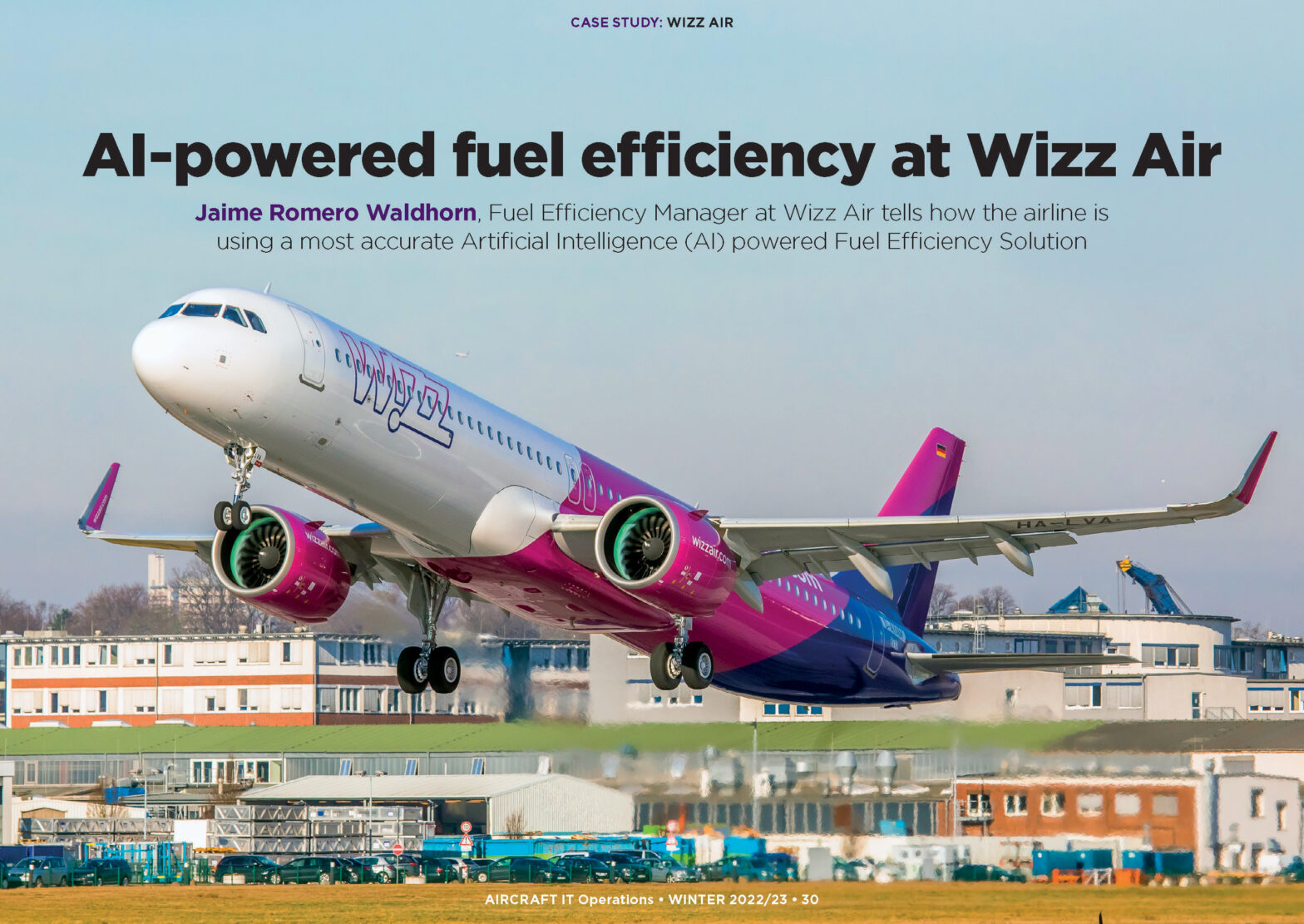
In the spirit of sharing good experiences with the hope that others can gain from them, I want to use this article to share our experience at Wizz Air with the implementation and the use of a most accurate fuel efficiency solution that harnesses data and full potential of artificial intelligence to provide high quality and actionable information on which good decisions can be based. But before even that, I’ll tell you about Wizz Air.
WIZZ AIR
Wizz Air, the fastest growing and most sustainable European ultra-low-cost airline, operates a fleet of 170 Airbus A320 and A321 aircraft. A team of dedicated aviation professionals delivers superior service and very low fares, making Wizz Air the preferred choice of 27.1 million passengers in the Financial Year F22 ending 31 March 2022. Wizz Air is listed on the London Stock Exchange under the ticker WIZZ. The company was recently named one of the world’s top ten safest airlines by airlineratings.com, the world’s only safety and product rating agency, and 2020 Airline of the Year by ATW, the most coveted honour an airline or individual can receive, recognising individuals and organisations that have distinguished themselves through outstanding performance, innovation, and superior service. Wizz Air was also rated the most sustainable airline in Europe by Sustainalytics in January 2022.
COOPERATION WITH STORKJET
Up until 2019, Wizz Air was using a legacy solution to perform its APM (Aircraft Performance Monitoring) process, involving a manual calculation of the aircraft performance deterioration (figure 1).
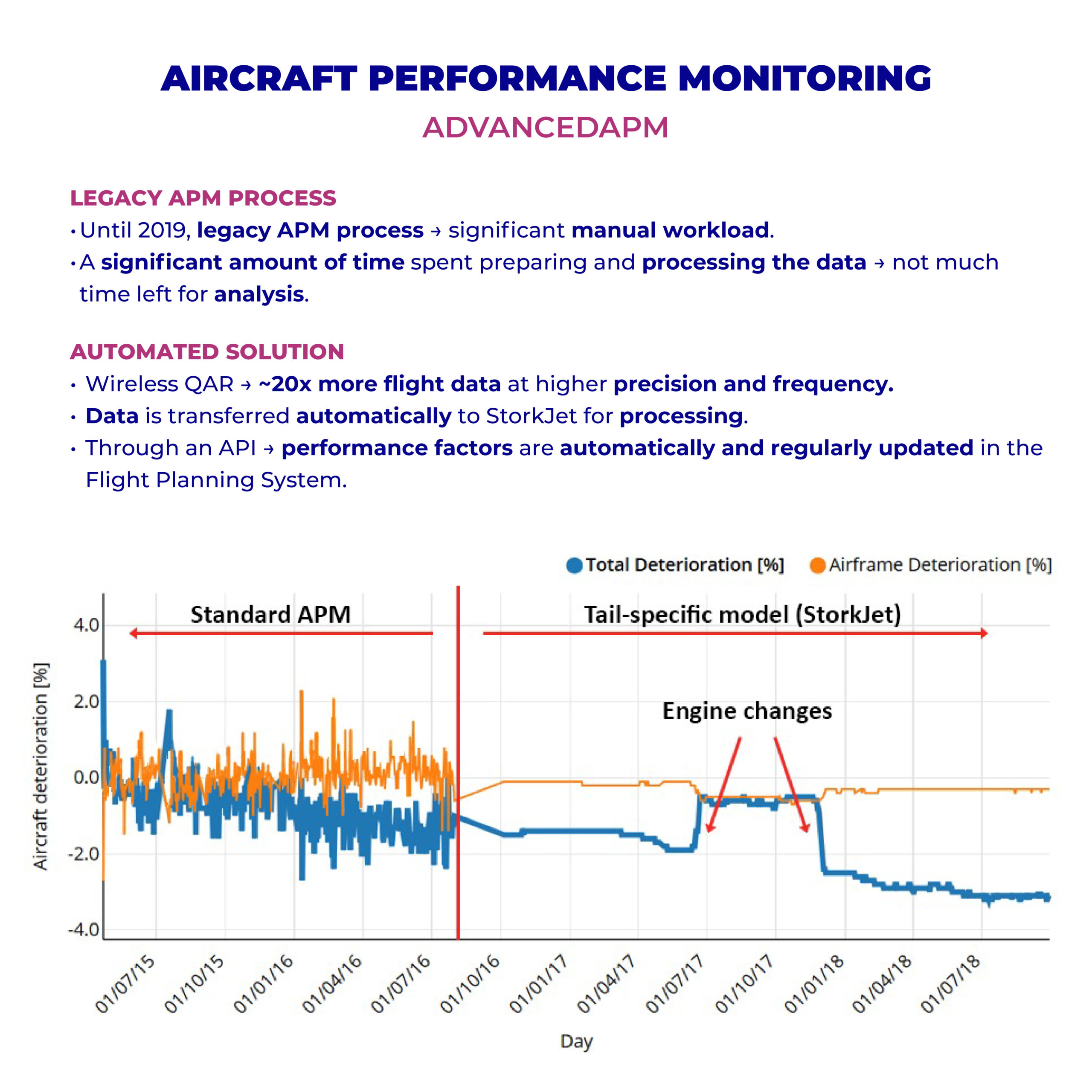
It was a time-consuming process, involving lots of data, that had to be done aircraft by aircraft on a quarterly basis. We wanted to move to a monthly calculation, but it proved to be quite challenging, creating the problem of spending more time processing the data rather than doing any actual analysis.
Considering this, we decided to implement AdvancedAPM, StorkJet’s fully automated solution for aircraft performance monitoring. Fortunately, Wizz Air aircraft are equipped with wireless QAR, so flight data is automatically transmitted to the airline’s servers when the aircraft is on the ground, and from there, directly to StorkJet. Using QAR data generates much more data for processing – even up to fifty stable segments – in which different parameters are measured, analyzed, and processed to measure actual performance against book level performance. Through an available API, we can integrate this information to update our Flight Planning System.
The aim of having these accurate and up to date performance factors in the Flight Planning System (figure 2) is to reduce overburns and to increase pilot’s confidence in the OFP’s fuel predictions.
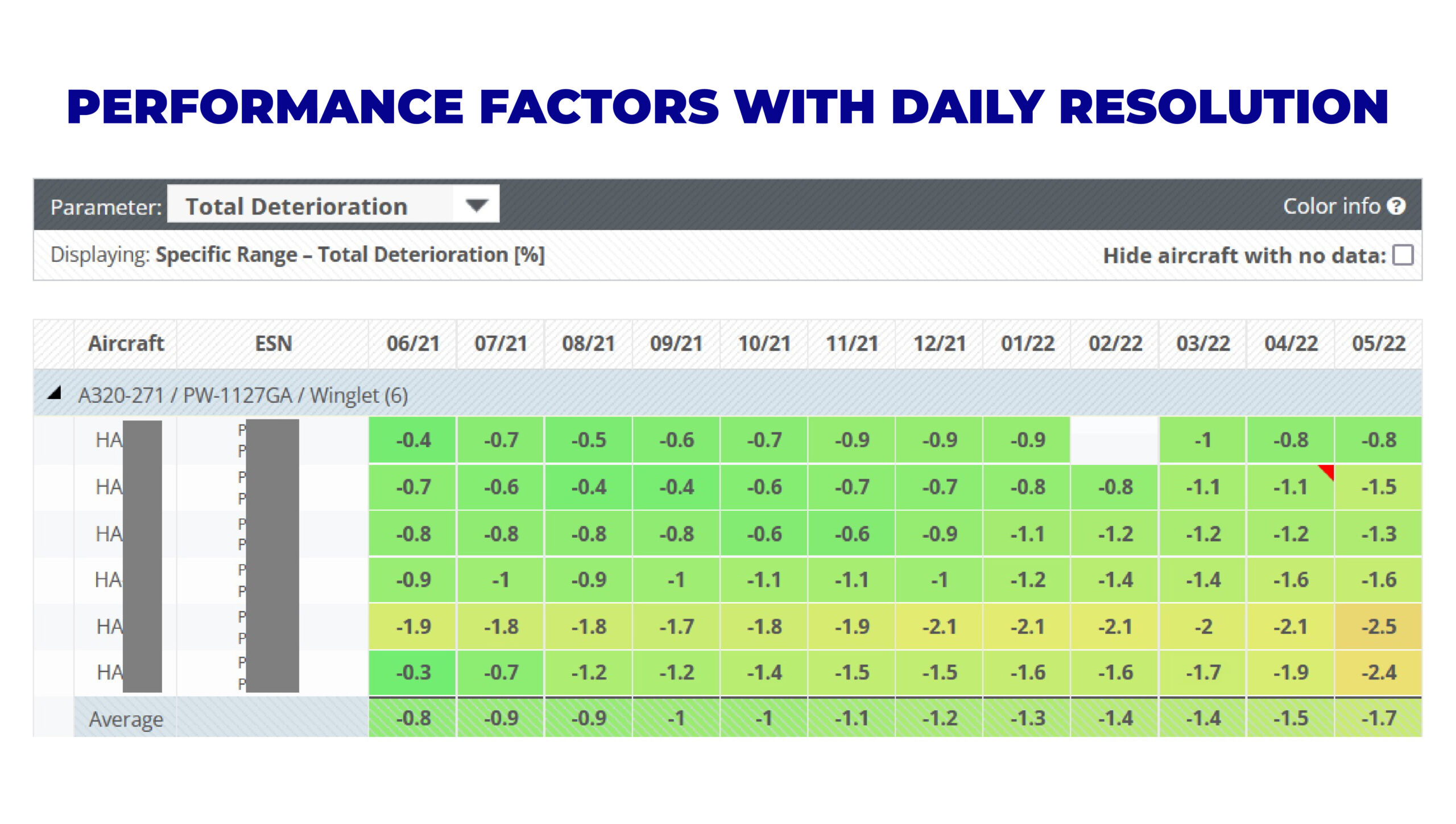
Moreover, it’s a safe way to reduce the use of discretionary fuel by the pilots if they consistently see that the planned fuel matches the actual fuel burn of the aircraft. At the same time, it reduces statistical contingency fuel since it’s calculated on the difference between planned and actual fuel burn.
We can further save on engine maintenance thanks to take-off thrust reduction monitoring which is also available in the StorkJet platform. Plus, in case of increased performance deterioration, the platform can help us identify the root cause of the problem. Additionally, automated alerts are received when such changes in the parameters take place.
Based on idle factors calculated by AdvancedAPM, we have been performing more fuel efficient descents (figure 3). Descent optimisation is a quite crucial action to reduce CO2 emissions.
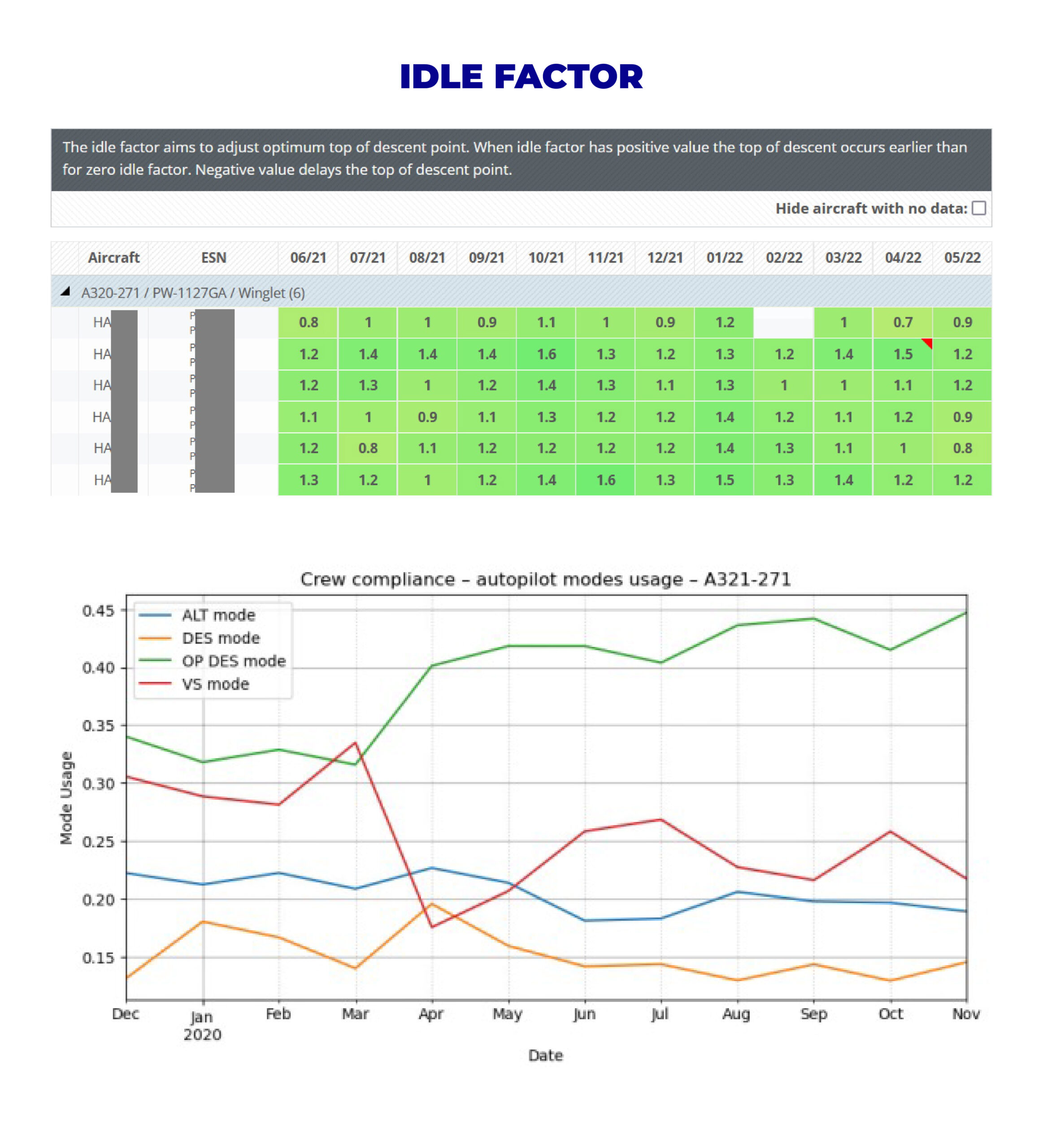
There are many external factors that are not in the airline’s nor the pilot’s control during the descent phase. The saving potential is substantial, but also limited by airspace restrictions. An optimal idle factor aids the FMS’ calculation of the TOD (Top Of Descent), minimising unnecessary levelled flight due to engine performance variations.
The use of accurate idle factors saves on average 7 kg of fuel per flight. On top of this, most of Wizz Air’s new aircraft are equipped with Airbus DPO, further expanding the saving potential during descent.
FUELPRO FUEL EFFICIENCY PLATFORM
Wizz Air had developed an in-house fuel efficiency platform, where QAR flight data was processed and integrated with other data sources (OFPs, load sheets) to measure compliance to a defined set of fuel saving initiatives. However, over time, it became a constraint when new fuel efficiency initiatives were planned to be introduced or further analysis was needed (figure 4).
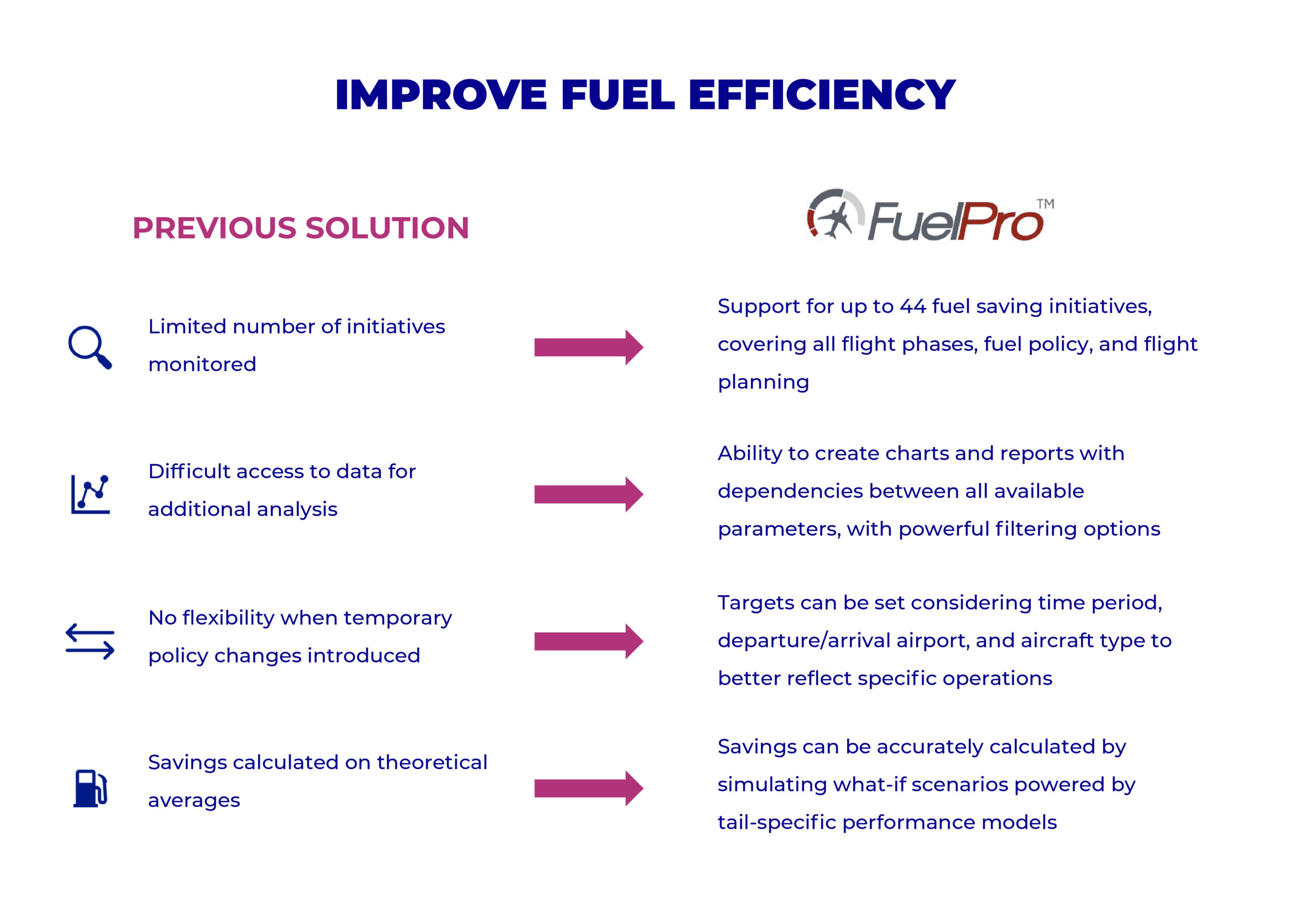
There were a limited number of initiatives that we were able to monitor. Besides, collecting the underlying data to generate ad-hoc analyses (e.g., trying to correlate overburns with flight planning parameters) involved an IT request which could take a couple of days. There was little to no flexibility when policy changes were introduced, even if they were temporary. And finally, all the savings were calculated based on assumptions or theoretical models: we were not assessing or simulating each flight and their actual flight conditions.
FuelPro, supports up to 44 different savings initiatives categorized by phase of flight – from fuel policy, flight planning, ground operations, departure, cruise and descent phase. Through the platform we can access all the parameters available to create charts and reports that we can save and download for analysis. Target setting is also fully customisable: depending on the initiative, we can set different targets by aircraft type, departure/arrival airport, time of the year, etc. We regularly update these values based on pilot feedback and experience, allowing us to have reliable and realistic goals. The savings for each initiative are calculated based on tail specific performance models within the platform, so that we can know precisely what the savings would have been for a given flight, for that specific aircraft at that specific gross weight and in those specific atmospheric conditions.
How FuelPro works in reality
Different users within Wizz Air use the platform differently (figure 5).
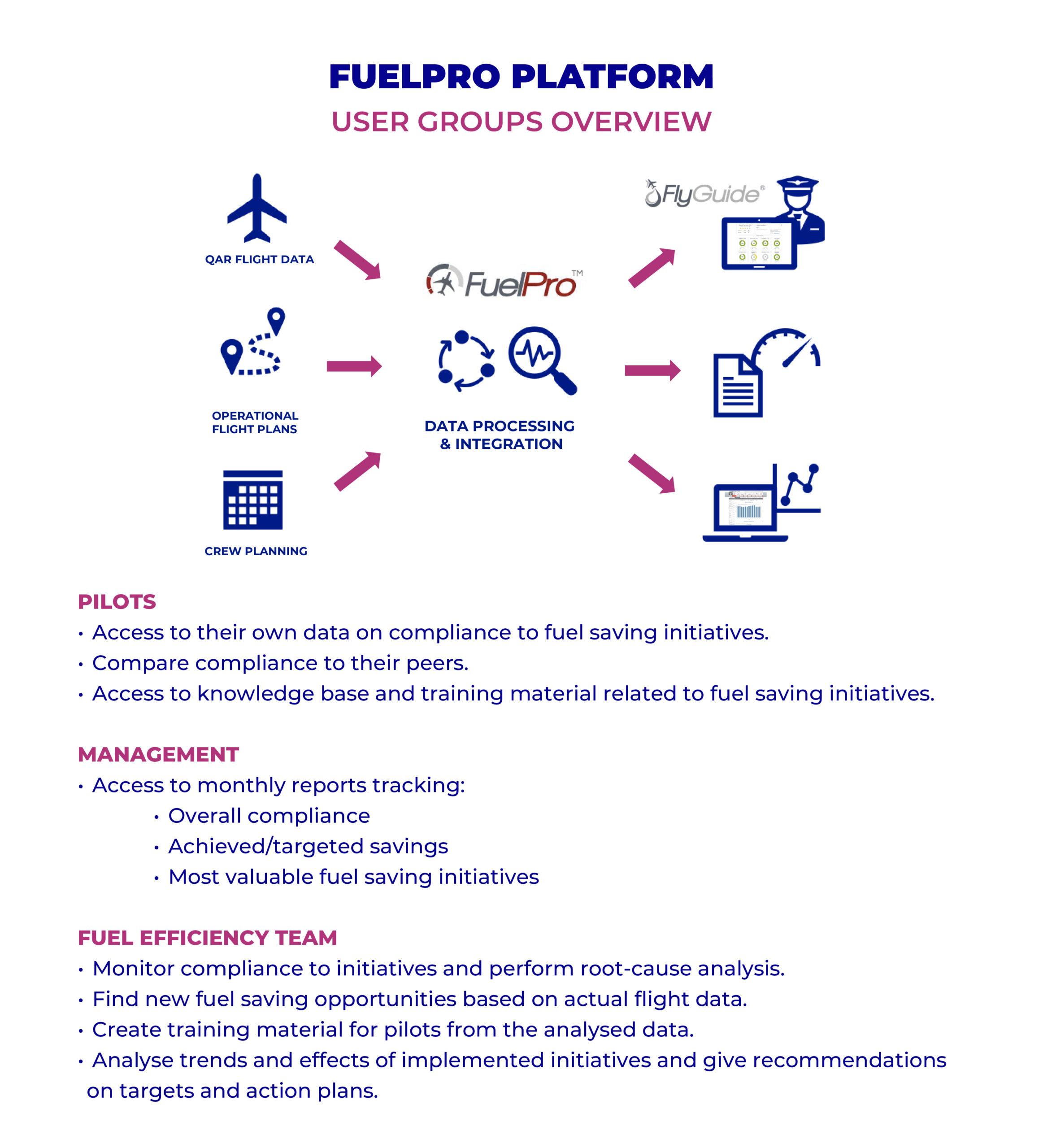
As mentioned before, QAR flight data was already shared with StorkJet’s AdvancedAPM platform, so no additional effort was required from our side to have this data also in FuelPro. Additional data sources needed for the platform were the OFPs produced by the Flight Planning System and crew planning information to match the crews to each specific flight. All the data is processed and integrated into a single platform.
There are several user groups within Wizz Air using this integrated source of data: pilots, for example, can access their own statistics on compliance to various fuel saving initiatives through FlyGuide, the available EFB app. Through this app, pilots can also get a better understanding on how the different fuel saving initiatives are measured and the reasons behind their implementation.
Airline management can have access to a set of customised dashboards, where they can get a quick overview of the progress of the whole Fuel Efficiency programme. The performance of the most significant fuel saving initiatives can be easily visualised by tracking their compliance over time and the associated predefined targets. At the same time, the initiatives with the highest saving potential can be identified, so we know where to put our efforts to assure a successful programme.
In the Fuel Efficiency team, we can monitor compliance in a much greater detail for an even larger set of initiatives. Additional analyses can be performed in case we identify a decline in compliance at a particular airport or specific aircraft type. At the same time, we can precisely measure the impact of a policy change in our operations, regardless of a possible limited applicability. It also gives us the possibility to find new fuel saving opportunities by using advanced filtering or by creating completely customisable reports and charts, with every flight parameter available for analysis and correlation.
FUEL EFFICIENCY ANALYSIS
During the implementation period, we worked closely with StorkJet on creating an extensive assessment on optimisation opportunities in our operations. Using tail-specific fuel burn prediction models, the estimated saving potential for 44 fuel initiatives was calculated. For internal validation and alignment, we conducted workshops with experts from different operations departments and StorkJet. We created reliable targets and, in some areas where we thought there was no room for improvement, we discovered additional opportunities for further optimization. In the end, we identified the ten fuel initiatives with the highest saving potential, including improvements in the final reserve fuel calculation, contingency fuel, climb speed, and statistical taxi time.
Final Reserve Fuel
Wizz Air implemented some improvements in the Flight Planning System regarding the calculation method for final reserve fuel (figure 6).
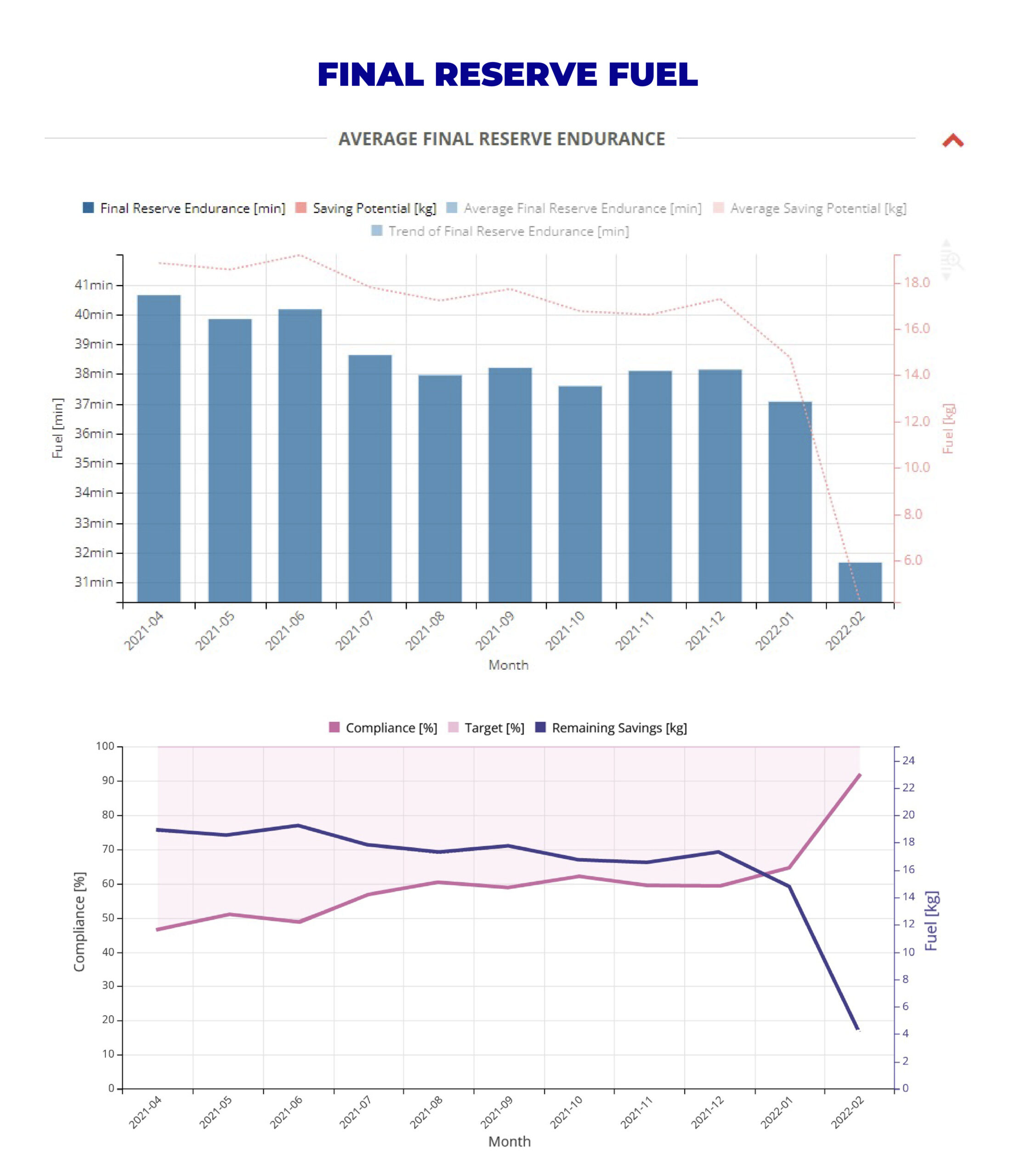
FuelPro has the capability to calculate final reserve fuel endurance for each flight, considering the estimated weight at the planned alternate airport. Figure 6 shows on average final reserve fuel endurance over time (on the left) and compliance with remaining savings over time (on the right). It’s clearly visible the reduction in final reserve fuel endurance from around 38 minutes to an average of 32 after the implementation of the initiative. At the same time, we see that compliance (pink line) goes up and remaining savings (blue line) go down. It’s important to note that the endurance is calculated on actual expected fuel on board at the alternate airport, meaning that non-used planned/contingency/extra fuel will be part of the calculated endurance.
Contingency Fuel
With FuelPro, we can easily monitor contingency fuel planned and the applied policy. We introduced 3% contingency fuel policy (instead of 5%) for routes in which there’s not enough data to calculate statistical contingency fuel and certain conditions are met. We also found that around 5kg of fuel savings were achieved after implementation of the initiative. As you can see in figure 7, compliance went up well over the set target of 90% and the saving potential stayed close to zero.
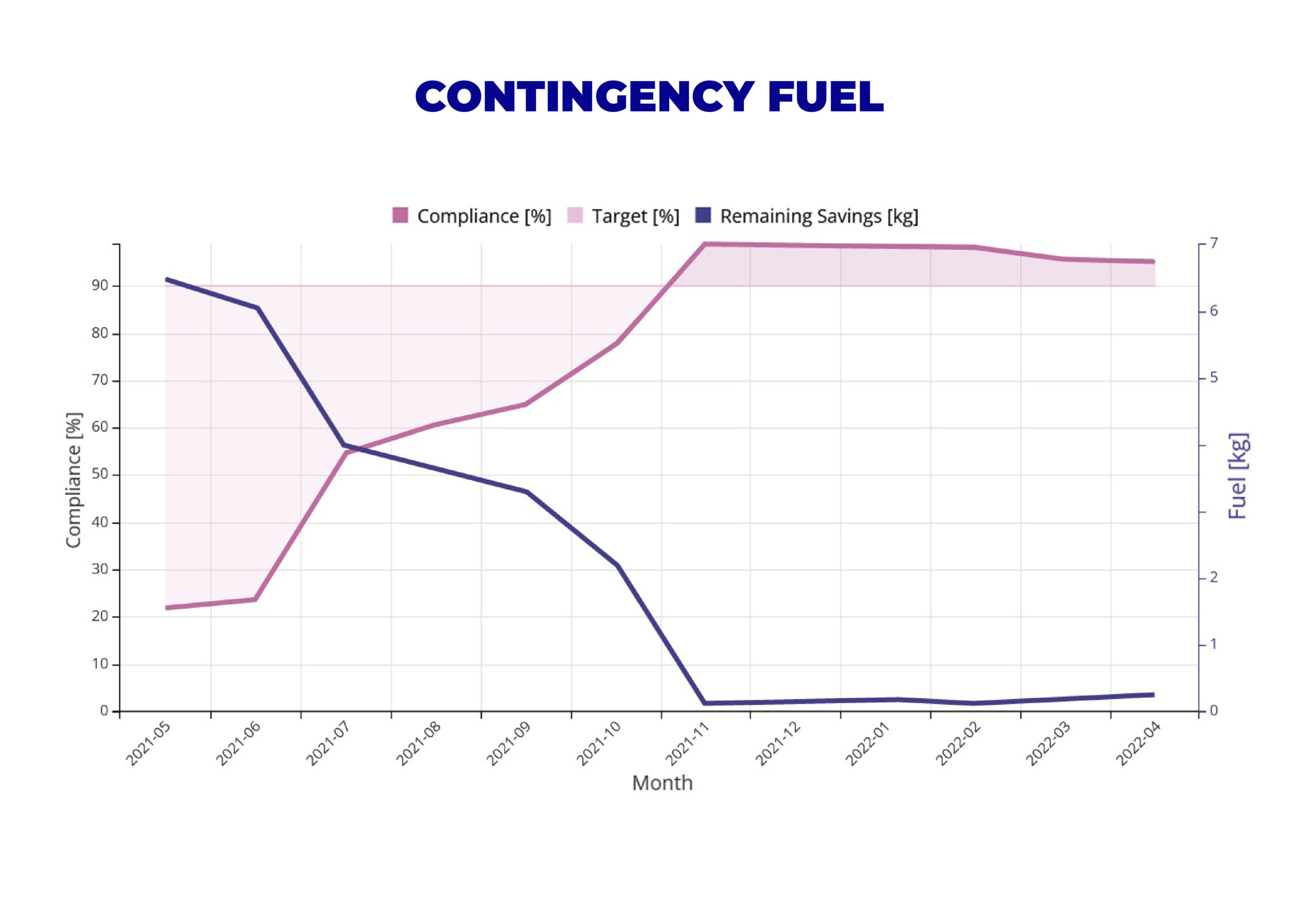
A320neo Climb Speed
During the implementation of the platform, we discovered that the calculated FMS ECON speed was 15 to 20 knots higher than the optimal calculated by the tail specific performance models from StorkJet.
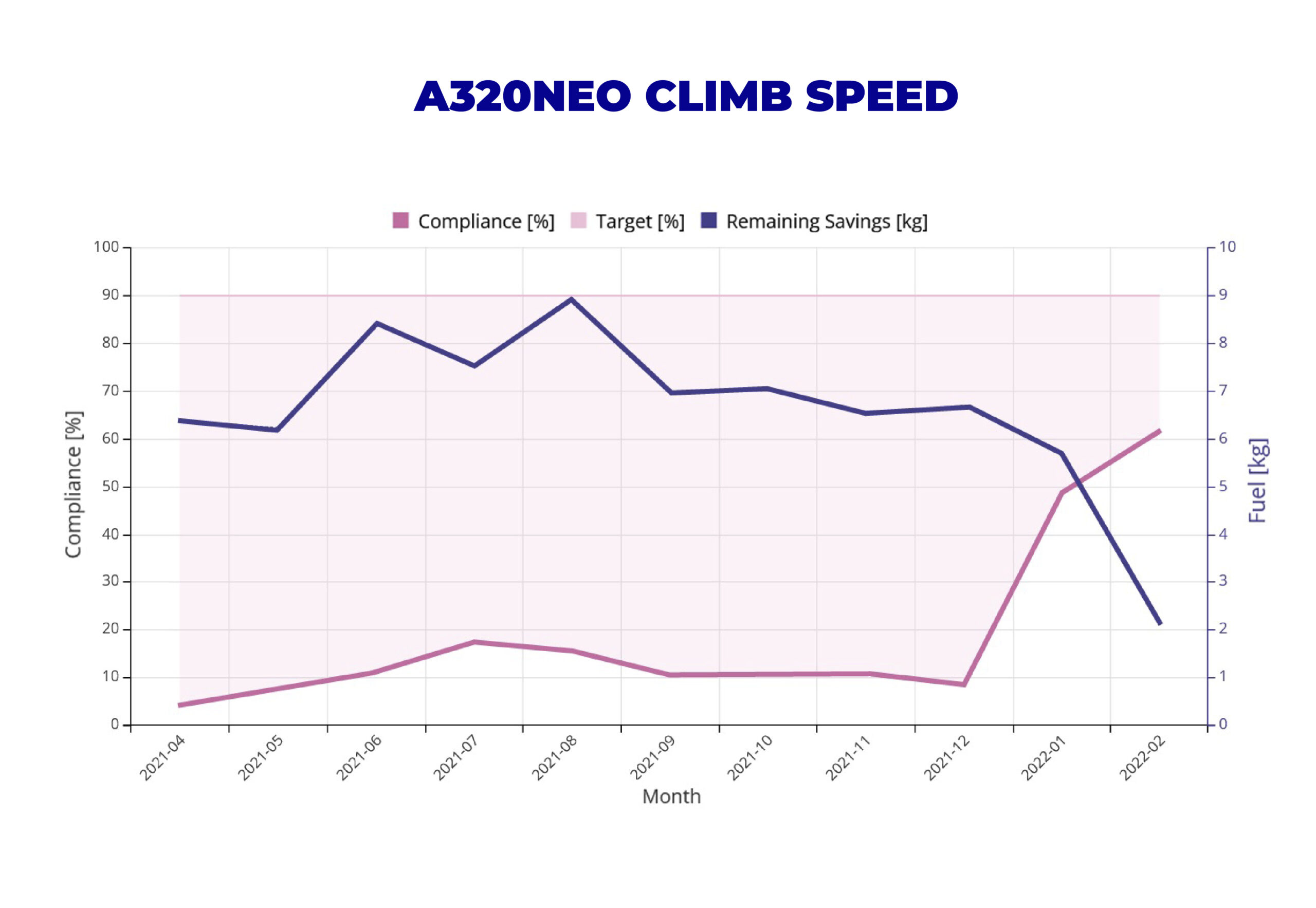
Based on this discovery, we introduced a recommendation to pilots to reduce the FMS ECON climb speed, saving around 5-6 kilograms per climb. The introduction of this policy can be clearly seen in figure 8, where the compliance (pink line) went from around 10% to slightly over 60%. Consequently, an abrupt reduction in the calculated remaining savings was also observed.
Statistical Taxi Time
Another initiative that we’ve been working on since the implementation of FuelPro is statistical taxi time. The FuelPro platform enabled us to see the difference between taxi out fuel planned and actual taxi fuel used (figure 9).
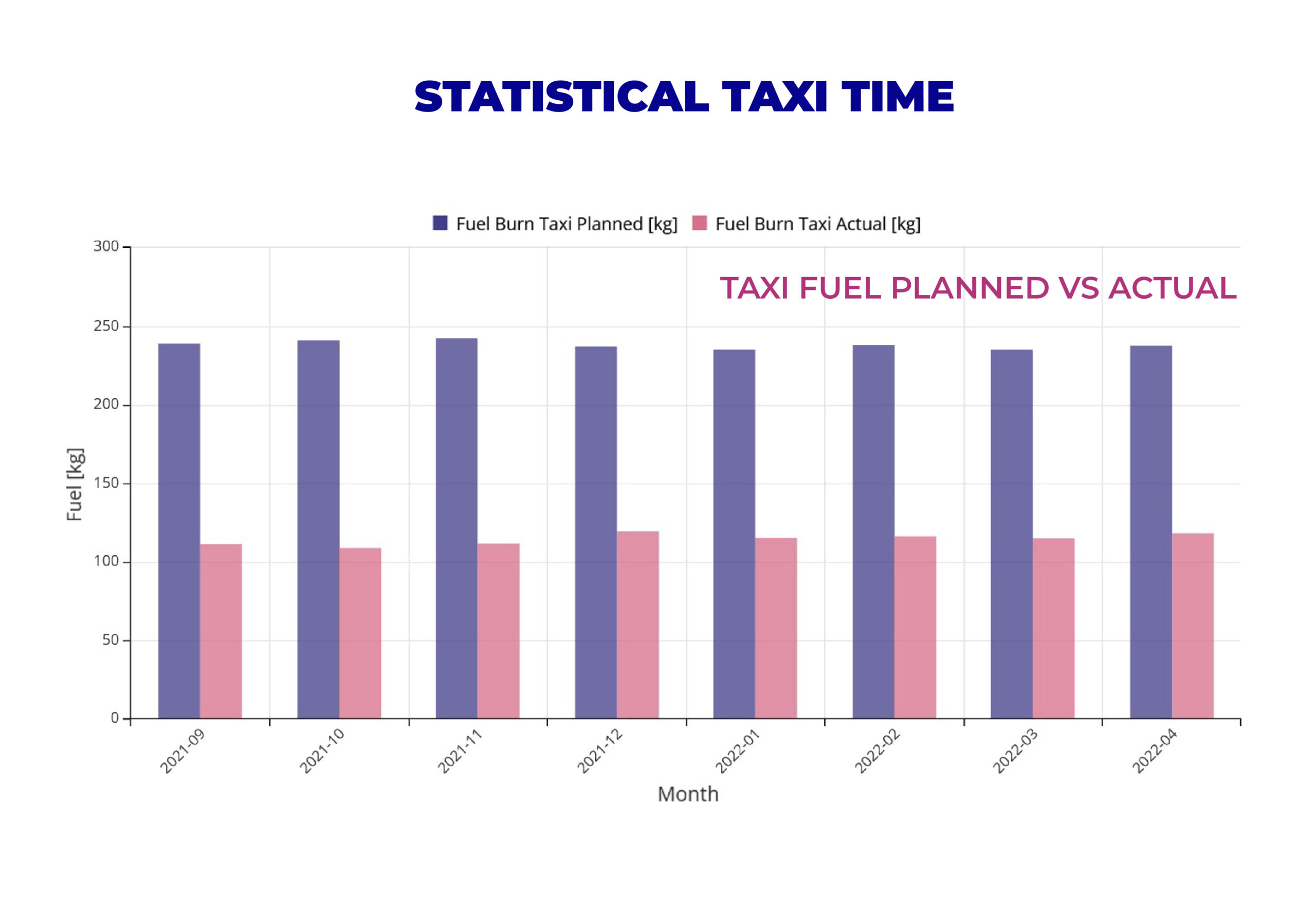
Figure 9
As figure 9 shows, planned taxi fuel almost doubles (on average) actual taxi fuel burn. The platform provides us with statistical data for each airport and performance type, and we can automatically link this data to our Flight Planning System to be used in the OFP calculation. Through modelling, we can use different confidence intervals and different weights to past data, in order to account for seasonality or sudden changes in the operations. A conservative 95% confidence interval translates to a reduction on planned taxi fuel of around 25%, saving around 4kg of fuel per flight.
FLYGUIDE PILOT APP
FlyGuide is the EFB app to engage pilots in flying more fuel efficiently. At Wizz Air, we strongly believe that involving pilots is key in the success of the Fuel Efficiency programme. It gives them operational information not available to them before and empowers them to make more informed decisions.
The goal is to not overload the pilots by presenting too much information, but to select only those areas/initiatives, which can bring the highest savings. They get an overall fuel score, calculated as the weighted average of the individual compliance to the selected fuel initiatives. The information is available for the last 12 months, giving them the opportunity to identify any past trends for additional saving opportunities. The overall fuel and CO2 saved for the given period is also displayed, together with the remaining saving potential based on the current compliance.
In figure 10, we can see a screenshot of the iOS app showing how pilots can explore their own compliance over time, considering the full set of fuel initiatives chosen by Wizz Air.
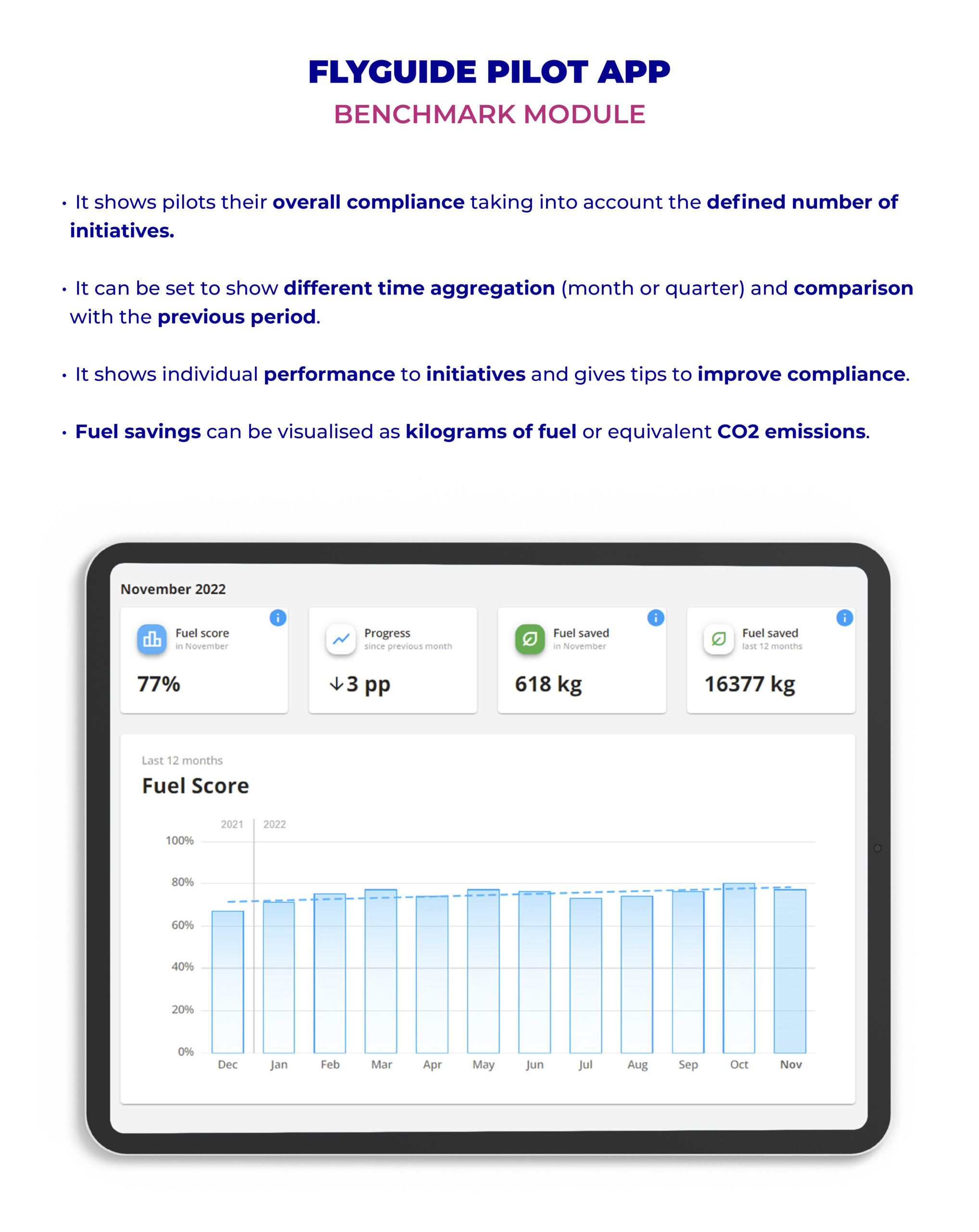
In contrast, figure 11 shows compliance evolution over time for a specific fuel initiative. In this view, they can also visualise the target set, achieved savings, and their individual trend for the last 12 months.
With these tools, pilots can get a better understanding of the fuel burn impact of operational changes of any initiative. They can be more involved in fuel policy/operational procedures and increase confidence when providing feedback.
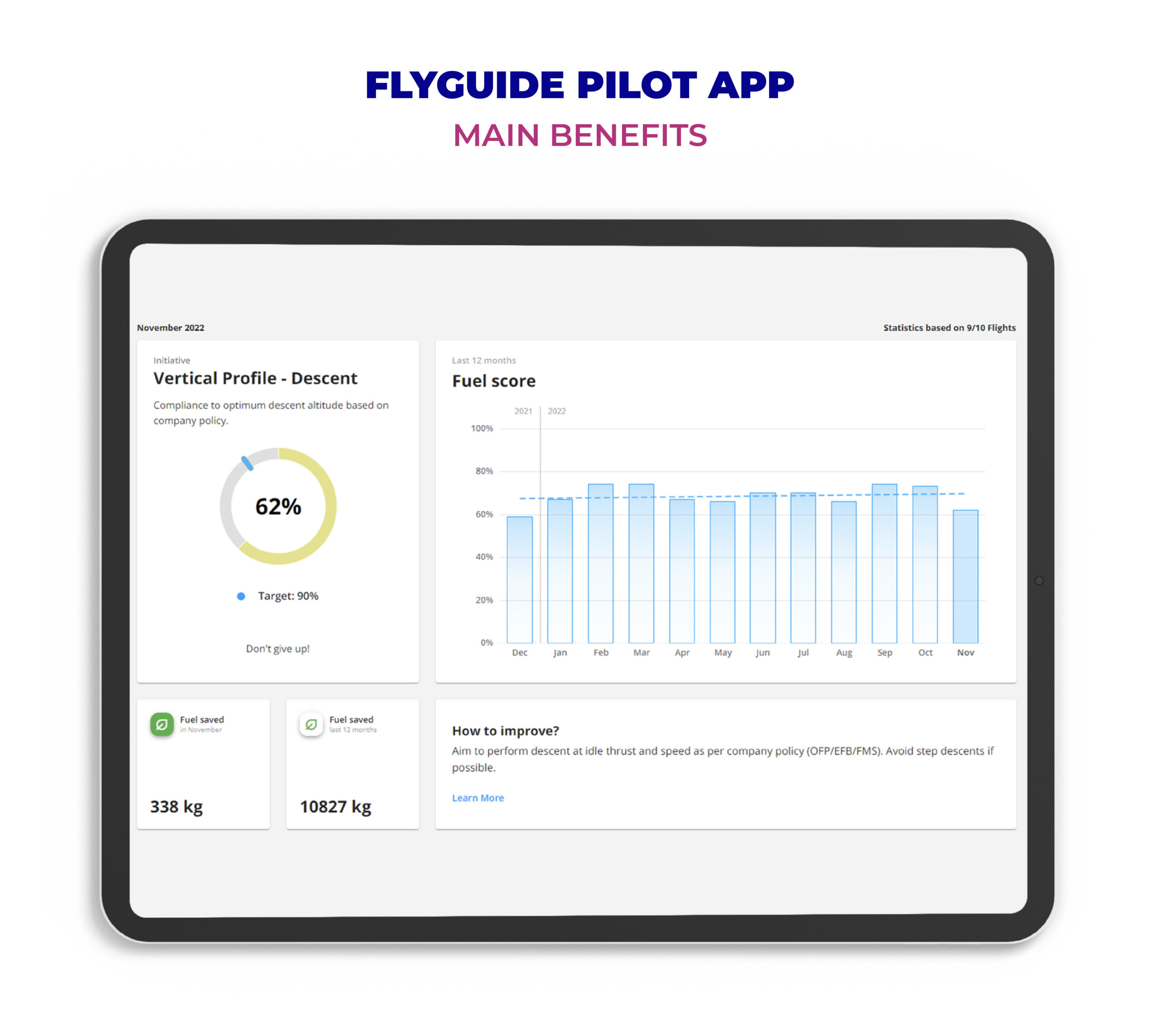
Figure 11
Another module available in the app shows the last 30 flights, highlighting how the flight was performed according to the enabled initiatives, remaining savings by initiative, fuel consumption difference with the OFP, and planned route vs actual route flown.
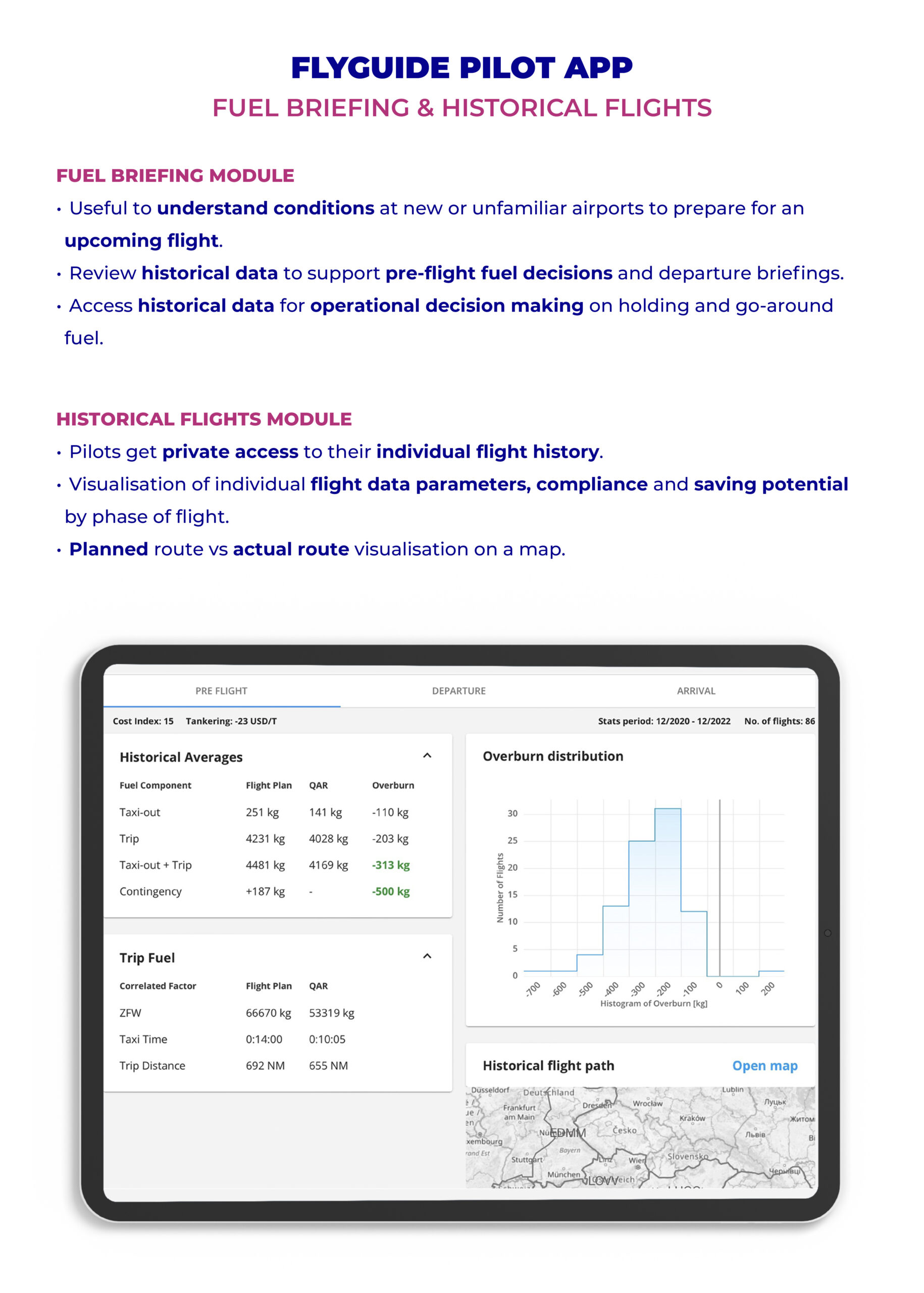
The latest addition to FlyGuide is the Fuel Briefing module, in which pilots can better prepare for any upcoming flight. Based on historical data, pilots can get quick insights on how past flights for the same city pair were performed. Figure 12 shows the tab with some of the most relevant pre-flight information, such as historical overburn distribution, historical trip and taxi fuel difference, historical delay time, and trip distance. The map at the bottom rights display the actual route planned (according to the latest OFP revision) and the actual route taken by past flights. With this information, pilots can more proactively request enroute shortcuts. Similar information is displayed in the departure and arrival tabs: historical routes for the same planned runways are displayed on a map, together with information on most efficient configuration (flaps, single engine taxi, etc.) from the planned departure/arrival runway. Furthermore, taxi-out and taxi-in routes are displayed per departure/arrival runway (with expected taxi times), with guidance on the most optimum point to perform single engine taxi.
That’s our story at Wizz Air and I hope it will prove useful for readers.
Contributor’s Details
Jaime Romero Waldhorn

Jaime Romero Waldhorn is Fuel Efficiency Manager at Wizz Air. He has a master’s degree in Traffic and Transport from the TU Darmstadt in Germany and over ten years of experience in the airline industry. Since 2018 he has been part of Wizz Air, starting his current role in 2020, overseeing the introduction and the monitoring of fuel efficiency initiatives.
Wizz Air

Wizz Air is an European ultra-low-cost (ULC) airline with its head office in Budapest. The airline serves many cities across Europe, as well as some destinations in North Africa and the Middle East. With 170 aircraft across several types from the Airbus A320 family, it currently serves over 190 destinations in 51 countries.

